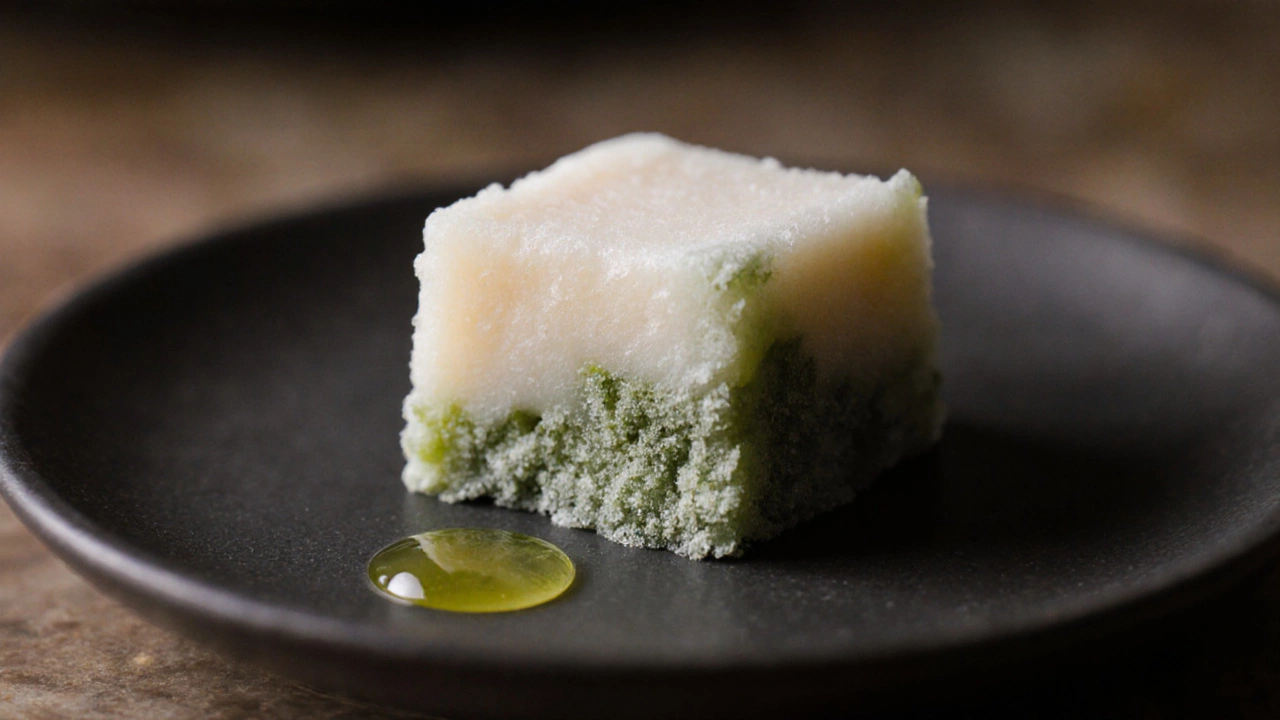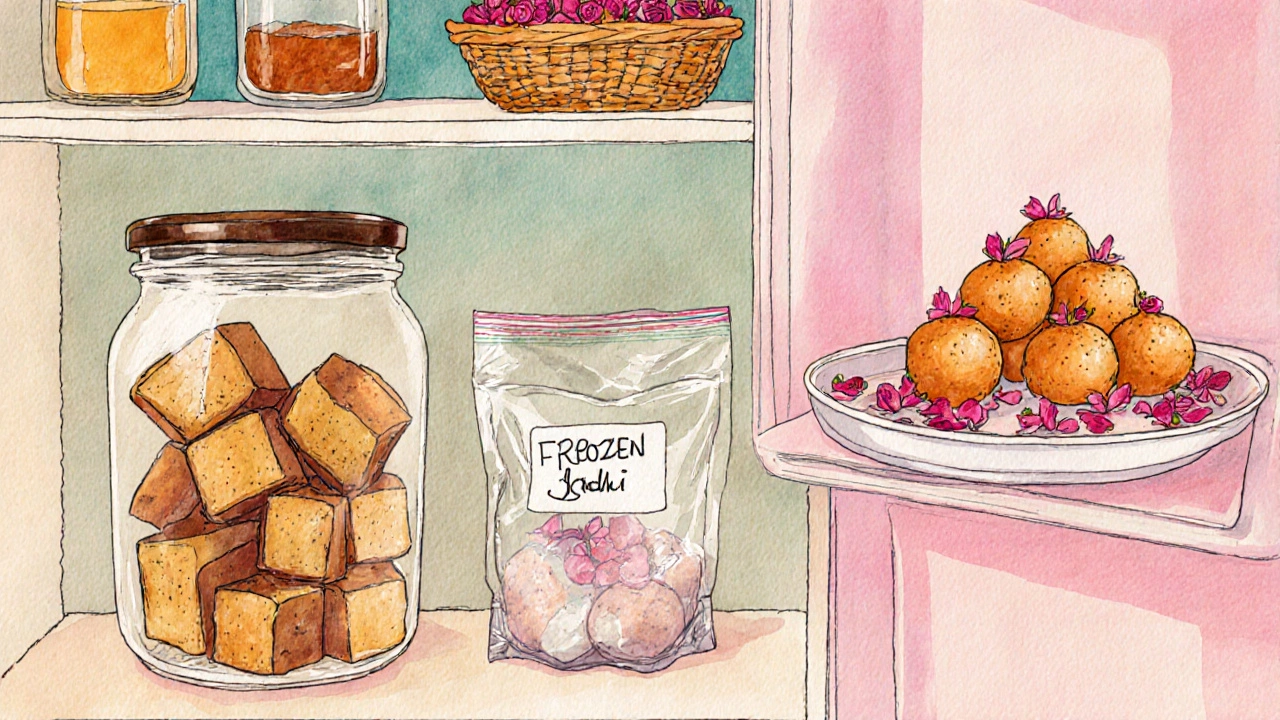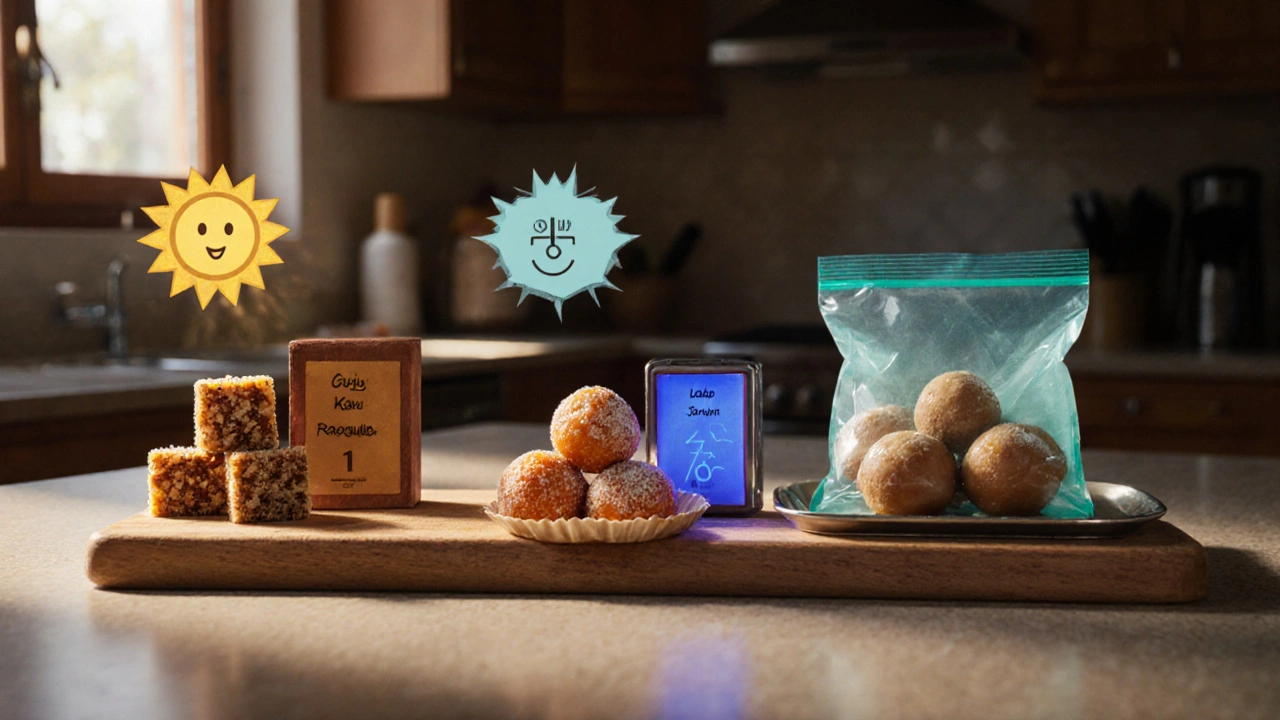Indian Sweet Shelf Life Calculator
Calculate Freshness Duration
Enter your sweet type and storage method to get accurate shelf life estimates
Quick Takeaways
- Most Indian sweets stay fresh for 2‑5 days at room temperature, 1‑2 weeks in the fridge, and up to 3 months frozen.
- High‑fat ingredients like ghee clarified butter that adds richness and helps preserve taste can extend shelf life, while fresh milk‑based sweets spoil fastest.
- Watch for off‑smells, mold, or a sticky film - signs that the sweet has gone bad.
- Store in airtight containers, keep away from sunlight, and use refrigeration for moisture‑rich treats.
- Freezing is the best way to keep sweets like gulab jamun or laddu for months without loss of flavor.
What Do We Mean By ‘Going Bad’?
When a treat “goes bad,” you’re usually dealing with microbial growth, oxidation, or texture breakdown that makes it unsafe or unpleasant to eat. For Indian sweets, the culprits are often bacteria, yeasts, or mold that thrive in warm, moist environments. Even if a sweet looks fine, hidden spoilage can produce off‑flavors or harmful toxins.
Key Factors That Influence Shelf Life
Understanding why some sweets last longer than others helps you store them smarter. Here are the main drivers:
- Ingredient composition: Sweets heavy on sugar a natural preservative that reduces water activity last longer than those relying on fresh dairy.
- Moisture content: Moisture content the amount of water retained in a confection provides a breeding ground for microbes. Firmer sweets like barfi are safer at room temperature than syrup‑soaked gulab jamun.
- Fat type: Ghee provides a stable fat that resists rancidity compared to butter helps extend shelf life, especially in deep‑fried sweets.
- Acidity: Lower pH (like in rasgulla) slows bacterial growth, while neutral pH sweets are more vulnerable.
- Storage temperature: Refrigeration keeps foods at 4°C (39°F) to slow microbial activity can add days or weeks, whereas room temperature (20‑25°C) speeds spoilage.
Typical Shelf Life by Sweet Type
Below is a quick reference. Times are averages; actual duration depends on freshness of ingredients and storage conditions.
| Sweet | Room Temp (≤25°C) | Refrigerated (4°C) | Frozen (‑18°C) |
|---|---|---|---|
| Barfi (nut‑based) | 3‑5 days | 1‑2 weeks | 2‑3 months |
| Gulab Jamun | 2‑3 days | 1‑2 weeks | 2‑3 months |
| Laddu (besan) | 4‑6 days | 2‑3 weeks | 3‑4 months |
| Rasgulla | 2‑3 days | 1‑2 weeks | 2‑3 months |
| Kaju Katli | 5‑7 days | 2‑3 weeks | 3‑4 months |
| Khoya‑based sweets (e.g., peda) | 2‑4 days | 1‑2 weeks | 2‑3 months |

How to Spot a Sweet That’s Gone Bad
Trust your senses. Here are the red flags:
- Smell: A sour, rancid, or fermented odor means microbes are at work.
- Visual cues: White or green mold spots, excessive liquid pooling, or a slimy sheen are clear warnings.
- Texture change: Sweets that become overly hard, mushy, or sticky beyond their usual consistency have likely deteriorated.
- Taste test: If you’re unsure, take a tiny bite. A sharp bitterness or unexpected sourness suggests spoilage.
Best Practices for Storing Indian Sweets
Follow these steps to keep your treats safe and tasty.
- Use airtight containers: Glass jars with tight lids or food‑grade vacuum bags prevent moisture exchange.
- Cool, dark place for low‑moisture sweets: Barfi, halwa, and kaju katli can sit on the countertop if you’ll eat them within a few days.
- Refrigerate moisture‑rich sweets: Gulab jamun, rasgulla, and any product made with fresh milk should go in the fridge immediately after cooling.
- Freeze for long‑term storage: Portion into single‑serve bags, label with date, and thaw in the fridge overnight before serving.
- Avoid cross‑contamination: Never place a used spoon back into the container; use fresh utensils each time.
- Keep away from strong odors: Since sweets absorb smells, store them away from onions, garlic, or fish.
Extending Shelf Life Without Losing Flavor
Sometimes you need to prep ahead for festivals. These tricks help:
- Lightly coat with ghee: A thin layer creates a barrier against air.
- Add natural preservatives: A pinch of lemon juice (acidic) or a few drops of rose water can inhibit bacterial growth.
- Use sugar syrup: Dipping sweets in a boiled sugar solution (1:1 ratio) raises sugar concentration, making the environment less hospitable to microbes.
- Vacuum‑seal before freezing: Removes oxygen, reducing freezer burn and oxidation.

Common Myths About Indian Sweet Storage
Let’s bust a few false beliefs that can actually hurt the quality of your desserts.
- Myth: “If it looks fine, it’s safe.” Even invisible bacteria can multiply; always check smell and texture.
- Myth: “Freezing ruins the texture.” Properly wrapped sweets retain texture; only the outer surface may become slightly grainy, which disappears after gentle reheating.
- Myth: “All sweets last forever because of sugar.” Sugar helps, but high moisture or dairy content still limits shelf life.
What To Do If You Suspect Spoilage
When in doubt, throw it out. Food safety rules recommend discarding any sweet that shows mold, off‑odors, or unexpected texture. The risk of food‑borne illness isn’t worth a few rupees.
Frequently Asked Questions
How long can I keep homemade gulab jamun at room temperature?
Homemade gulab jamun should be eaten within 2‑3 days at room temperature. After that, refrigerate to extend freshness up to two weeks.
Can I freeze laddu without losing flavor?
Yes. Place laddu in a single‑layer on a parchment sheet, freeze solid, then transfer to a zip‑lock bag. Thaw in the fridge and enjoy; flavor remains virtually unchanged.
Is it safe to eat barfi after it develops a slight white film?
A white film usually indicates mold. Discard the barfi immediately; even a small amount can spread toxins.
What’s the best container for storing sweets long‑term?
A glass jar with a rubber seal works great for short‑term storage, while vacuum‑sealed zip‑lock bags are ideal for freezing.
Do spices like cardamom affect shelf life?
Spices have natural antimicrobial properties, so a modest amount can help slow spoilage, but they don’t replace proper refrigeration.
Can I store sweets made with fresh cream in the pantry?
No. Fresh‑cream desserts should be refrigerated right after cooling. At room temperature, they can turn sour within a day.
Is it okay to reheat frozen barfi before serving?
Yes. Thaw in the fridge, then gently warm in a microwave (10‑15 seconds) or on low heat, stirring to restore its smooth texture.
Next Steps for Home Cooks
Now that you know the signs, storage tricks, and shelf‑life timelines, you can plan ahead for festivals, birthdays, or casual gatherings. Start by:
- Labeling every jar with the date you made the sweet.
- Investing in a small vacuum sealer for batch‑freeze sessions.
- Keeping a simple chart (like the one above) in your pantry for quick reference.
Enjoy your treats with confidence-knowing they’re fresh, safe, and delicious.
